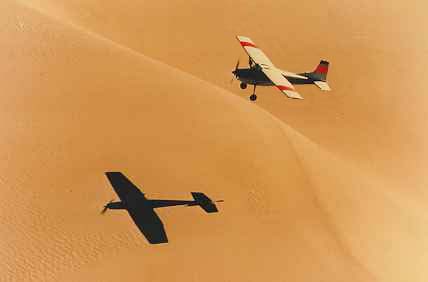|
THE NAMIB DESERT - Namibia, Africa. One of the oldest and driest deserts in the world. The dunes in the Namib can be almost 300 meters high, some of the highest in the world. This is caused by the shifting wind direction which forms what are known as "star dunes." Here, Timmissartok is seen over the section of the Namib just north of Luderitz. This is a scene from the National Geographic film "Flight over Africa." THE AIRCRAFT Claytor is using is a Cessna 180K. It is the classic bush plane, combining low maintenance and rugged construction with minimal cost of operation. It is a "taildragger" which means that it has a small wheel at the back instead of a nosewheel in the front. This makes the plane more difficult to land and take off, but enables it to land in the shorter, softer unprepared airstrips found in remote areas of the world. The plane has been fitted with a removable auxiliary fuel tank permitting an endurance of 14 hours and a range of 1,700 nautical miles (3,145 kilometers). This is necessary for the long cross-ocean flights that Claytor must make to move from one continent to the next. It is also necessary on a continent like Africa, where sometimes aviation fuel is hard to find and there are huge distances to cross - like the Sahara desert. Special equipment aboard the plane includes an autopilot, night vision scope, engine analyzer, digital fuel consumption indicator, stormscope, radar altimeter, VHF direction finder, high-frequency long-range communications radio, and a satellite global positioning system. When the trip began in 1990, the satellite system was still very new and not entirely reliable, so an A-10 aviation sextant was carried as an emergency back-up for the Atlantic Ocean crossing. The orange stripes on the wings and tail are a safety measure. If Claytor were to crash in a remote part of the world, the bright color might make it easier for him to be spotted from above.
|
